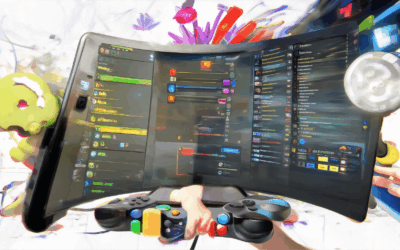As the gaming world continues to evolve, so too has the demand for immersive and engaging experiences. One of the most critical aspects of creating successful games lies in balancing difficulty levels to ensure they remain challenging yet accessible. This delicate dance between providing enough challenge to keep players engaged without overwhelming them is a cornerstone of great game design. Whether it’s ensuring that casual gamers can enjoy a game just as much as hardcore enthusiasts, or adapting to varying skill levels and preferences, dynamic game difficulty balancing plays a pivotal role in delivering a satisfying experience. From traditional titles to modern, complex games, mastering this balance is essential for developers and designers aiming to create memorable and enduring gameplay.
Here are the key takeaways from the article on effectively implementing dynamic game difficulty balancing:
- Define the Target Experience: Align gameplay balancing with desired outcomes such as casual fun or intense competition to ensure a tailored player experience.
- Analyze Player Feedback: Gather insights from beta tests, forums, and reviews to refine mechanics and progression, enhancing gameplay balance.
- Adjust Mechanics and Progression: Fine-tune elements like difficulty curves and enemy spacing to create a balanced and engaging experience.
- Use Balancing Tools: Implement tools such as difficulty scaling and leaderboards to maintain fairness and keep players engaged.
- Overcome Challenges: Address issues like progression alignment, combat mechanics, and server load to ensure a balanced and enjoyable gameplay experience.
- Leverage Resources: Utilize top tools like Unity and Unreal Engine, and explore guides from Indie Dev Games to enhance your game design and player experience.
These takeaways encapsulate the essential steps and considerations for achieving effective gameplay balancing, ensuring a fair and engaging experience for all players.

Why is Game Balancing So Difficult?
Game balancing is a complex and multifaceted endeavor that involves ensuring fair and enjoyable gameplay experiences for all players. Here are the primary reasons why achieving perfect balance in games is so challenging:
- Complex Variables : Modern games often feature numerous variables, including weapons, abilities, characters, and game mechanics. Balancing each element individually while ensuring they function cohesively together is a monumental task.
- Ongoing Adjustment : Balancing is not a one-time achievement. Player feedback, new strategies, and evolving meta-game dynamics require constant tweaking and refinement. Developers must continuously monitor and adjust to maintain balance.
- Diverse Playstyles : Games cater to a variety of playstyles, from aggressive play to methodical builds. Ensuring that no single approach dominates or becomes obsolete is crucial, adding significant complexity to the balancing process.
- Fairness Across Platforms : Games often span multiple platforms and regions. Balancing must remain consistent across all platforms to ensure a level playing field, which can be challenging due to differences in hardware and player bases.
- Competitive vs. Casual Play : Balancing must adapt to different play modes. Competitive play demands precise tuning to prevent dominant strategies, whereas casual play may allow for more lenient rules to enhance enjoyment.
- Player Perception : Perceived balance is as important as actual balance. Even minor discrepancies can lead to frustration or dissatisfaction, impacting a game’s popularity and longevity.
- Updates and Expansions : Introducing new content or features necessitates re-balancing existing systems to maintain overall equilibrium, requiring a delicate balance between innovation and stability.
In summary, the difficulty lies in managing a vast array of variables, responding to dynamic player feedback, addressing diverse playstyles, ensuring consistency across platforms, adapting to competitive and casual play needs, maintaining perceived fairness, and handling the challenges posed by updates and expansions.
What is a Balanced Game?
A balanced game is one that offers a diverse and inclusive experience, allowing players to engage with the game in multiple ways without overwhelming them with complexity. This balance ensures that the game remains accessible while still providing depth and challenge.
Key Characteristics of a Balanced Game:
- Multiple Playstyles : A balanced game provides several distinct methods for players to enjoy the game, catering to different preferences and skill levels.
- Fair Gameplay : The game mechanics are designed to ensure fairness, preventing any single strategy or playstyle from dominating.
- Depth and Variety : The game offers a rich array of content, features, and challenges that keep players engaged over time.
- Accessibility : Despite its depth, the game remains approachable, making it enjoyable for a broad audience.
Examples of Balanced Games:
- Puzzle Games : Titles like Sudoku or Tetris are excellent examples of balanced games because they offer challenging yet fair puzzles that can be enjoyed by players of all ages.
- Strategy Games : Games like Civilization or The Settlers of Catan provide deep strategic elements while maintaining a balance between different gameplay phases.
- Action-Adventure Games : Games such as The Legend of Zelda series combine exploration, combat, and puzzle-solving in a way that keeps the experience engaging without becoming overwhelming.
By focusing on these aspects, a balanced game creates a more enjoyable and immersive experience for its players.

Understanding the Psychology Behind Game Difficulty Balancing
The art of balancing game difficulty lies in creating a harmonious blend of challenge and frustration, two forces that drive engagement and keep players invested in their experience. This delicate balance is crucial for maintaining player interest and ensuring that the game remains enjoyable while still presenting a meaningful challenge.
Emotional Impact of Difficulty
Game difficulty serves as a double-edged sword, evoking a mix of positive and negative emotions. On one hand, it triggers frustration when players face insurmountable obstacles, which can lead to feelings of anger or disappointment. On the other hand, overcoming these challenges fosters a sense of accomplishment and boosts confidence, creating a rewarding experience. This emotional duality is key to keeping players engaged, as it alternates between moments of struggle and triumph.
Role of Motivation in Balancing
Challenge plays a pivotal role in motivating players. When presented with tasks that are just beyond their current skill level, players are driven to improve and learn new strategies. This intrinsic motivation is what keeps many gamers returning to their games. However, when the difficulty curve becomes too steep or unpredictable, frustration sets in, leading to disengagement or even player dropout. Striking the right balance ensures that players remain motivated without feeling overwhelmed.
Flow State and Immersion
The concept of “flow state” is central to the gaming experience. This psychological phenomenon occurs when players are fully immersed in an activity, experiencing a sense of joy and control. A well-crafted difficulty curve supports this flow state by providing consistent and predictable challenges that align with the player’s skill level. When difficulty is too easy, players may feel bored, while excessive difficulty can disrupt the flow, leading to frustration.
Best Practices for Implementing Balance
To master the balance between challenge and frustration, developers should:- Analyze Player Feedback: Regularly gather insights from players to understand how difficulty impacts their experience.- Iterate and Adjust: Continuously tweak difficulty levels based on testing and feedback, ensuring progression feels fair and rewarding.- Leverage Progression Systems: Design systems that allow players to grow and adapt, making challenges more manageable over time.- Test Extensively: Conduct thorough playtesting to identify pain points and ensure that the difficulty curve feels smooth and consistent.
By understanding these principles, developers can create games that challenge players effectively while maintaining a high level of engagement and satisfaction. The result is a gaming experience that is both mentally stimulating and emotionally rewarding, keeping players coming back for more.
This response provides a comprehensive exploration of the psychological aspects of game difficulty balancing, incorporating emotional insights, motivational factors, and practical implementation strategies. By focusing on these elements, we aim to enhance the player experience while ensuring long-term engagement and satisfaction.

What is Gameplay Balancing?
Gameplay balancing is a critical aspect of video game design that ensures fair play, enjoyable experiences, and a competitive yet accessible environment for players. It involves carefully adjusting various elements of a game to maintain equilibrium between challenge, reward, and engagement.
Steps to Achieve Gameplay Balance:
- Define the Target Experience : Clearly identify the desired player experience. Are you aiming for casual fun, intense competition, or a mix of both?
- Analyze Player Feedback : Gather insights from beta tests, forums, and reviews to understand what players enjoy and where they struggle.
- Adjust Mechanics and Progression : Modify game mechanics, such as difficulty curves, enemy spacing, and item drops, to ensure progression feels consistent.
- Test and Iterate : Continuously test changes, iterate based on feedback, and monitor player behavior to refine the balance.
- Implement Balancing Tools : Use tools like difficulty scaling, leaderboards, and reward systems to maintain balance over time.
Why is Gameplay Balancing Important?
- Fairness : Ensures all players have equal opportunities to succeed.
- Engagement : Keeps players interested by preventing frustration or boredom.
- Competitiveness : Creates balanced competition in multiplayer modes.
Tools and Resources:
For indie developers looking to master gameplay balancing, visit Indie Dev Games for tutorials, reviews, and community insights. Explore articles on game design and player experience to enhance your project’s balance and appeal.
By prioritizing gameplay balancing, developers can create memorable and enjoyable gaming experiences that resonate with players.
What Are the Key Challenges in Achieving Game Difficulty Balancing?
Balancing game difficulty is a complex task that requires careful planning and execution. Here are the key challenges faced by developers:
- Understanding Player Behavior : Players have varying skill levels, playstyles, and patience thresholds. Creating a balanced experience that caters to all while maintaining fairness can be challenging.
- Progression Systems : Designing a progression curve that aligns with difficulty levels without frustrating casual players or overwhelming hardcore gamers is tricky.
- Combat Mechanics : Ensuring that enemy encounters and boss fights are neither too easy nor impossible to defeat requires precise tuning.
- Server Load and Performance : Managing multiplayer servers to prevent lag or disconnections while maintaining balance can complicate matters further.
- Replayability and Variety : Offering multiple difficulty settings and content that keeps players engaged without making them feel too challenged or bored.
For more insights, visit Indie Dev Games to explore resources and guides tailored for independent developers.
Leverage tools like Unity and Unreal Engine to streamline your development process and achieve optimal difficulty balancing.

What Are the Key Challenges in Achieving Game Difficulty Balancing?
The process of balancing game difficulty presents several critical challenges that developers must navigate to ensure an optimal player experience. Below are the primary obstacles and considerations:
- Progression Systems : Designers must create a balanced progression path that aligns with player skill levels and objectives. Too rapid a progression can alienate players, while too slow can lead to boredom. This requires careful tuning of XP, leveling, and resource accumulation rates.
- Difficulty Curve : Managing the difficulty curve is essential. Players expect a steady increase in challenge, but abrupt spikes or plateaus can frustrate them. Balancers must analyze playtest data to refine enemy spacing, damage outputs, and environmental hazards to maintain engagement.
- Player Feedback Mechanisms : Implementing systems to gather and act on player feedback is crucial. Surveys, in-game telemetry, and community forums provide valuable insights into what players perceive as balanced or unfair. Actively responding to this feedback ensures continuous improvement.
- Replayability and Variety : Offering multiple ways to approach challenges keeps gameplay fresh. This includes diverse enemy types, unlockable abilities, and alternative strategies, ensuring that players don’t feel repetitive or trivialized.
- Technical Challenges : Balancing on different platforms and devices can introduce complexities due to varying hardware capabilities. Ensuring consistent difficulty across PC, consoles, and mobile requires thorough testing and optimization.
- Fairness Across Platforms : Players expect identical experiences regardless of their device. Balancers must ensure that game mechanics remain consistent and that no platform advantage unfairly affects gameplay balance.
- Dynamic Content and Updates : As games evolve through updates and expansions, difficulty balancing must adapt accordingly. New content should integrate seamlessly with existing challenges, requiring ongoing monitoring and adjustments.
- Player Retention and Engagement : Difficulty balance plays a role in keeping players invested. Overly challenging sections risk frustration, while too easy content may lead to disengagement. Striking the right balance is key to maintaining long-term player interest.
- Global Playtesting and Localization : Testing across diverse regions and cultural contexts ensures that difficulty perceptions align globally. Understanding local preferences helps in tailoring challenges to resonate better with different audiences.
- Iterative Testing and Optimization : Balancing is rarely static. Regular playtesting, data analysis, and iterative adjustments are necessary to continuously refine difficulty levels based on real-world feedback and performance.
By addressing these challenges thoughtfully, developers can create engaging and fair gameplay experiences that cater to a broad audience. For more insights and resources on mastering game balancing, visit Indie Dev Games , your go-to hub for indie developers. Explore tutorials, reviews, and tips to enhance your project’s success.




0 Comments